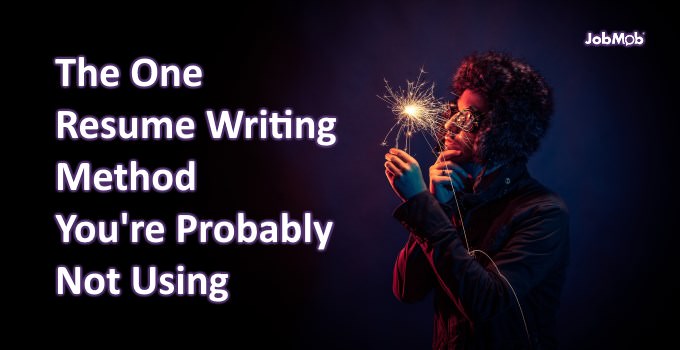A simple, 5-step formula for an effective resume that gets interviews.
This is a guest post by Andrew Rondeau.
What is the aim of a resume?
To get an invite for an interview.
That’s it.
Simple.
So how do you get that invite?
By ensuring that your resume sells you. It should be a sales advert for you and the easiest way to do that is via your skills and your achievements.
Research shows that if you get your resume right, you could actually boost your starting salary by 15%! Isn’t that reason enough to invest some time and get it right?
Avoid being in the majority
I get to see hundreds of resumes every week and the vast majority of them are just a list of educational courses, exam results and jobs. That’s it. No selling of themselves.
If you do not shout about your skills and achievements, how will employees know about them?
Note: There is a poll embedded within this post, please visit the site to participate in this post's poll.Free bonus: The One Resume Resource You’ll Ever Need is a handy reference to make your resume get you more job interviews. Download it free now
Here’s a sure-fire way to get your resume right
This is how you write a simple yet effective resume for your next job:
- Make a list of courses and jobs you’ve taken or done, including any voluntary work
- List the skills that each course and job gave you
- Add your achievements using each skill
- Include specific facts and figures
- Then flesh out this information to create your resume
Focus on where you have had success
For example, let’s say you worked in a call centre of some sort. Instead of just writing:
“IT Helpdesk Advisor, February to May 2008”,
Add the skills as well:
“Knowledge of numerous IT packages including…”
“Calm collective approach to customers when dealing with a crisis”
Add the achievements as well:
“Gained teamwork skills as part of the team of five, led the team as stand-in for Team Leader in their absence”
“Increased first-time customer complaint resolution rate”
Adding facts: a unique approach
In my experience, by far the biggest gap in resumes is the inclusion of facts. Individuals just do not include them. An easy way to approach this is to say “So what?” after each statement and see what facts you can add.
Let’s use this achievement statement as an example:
“Increased first-time customer complaint resolution rate”
Ask “So what?”
A better statement would be:
“Increased first-time resolution rate for all customer calls from 65% to 82%”
Let’s ask again – “So what?”
An even better statement would be:
“Increased first-time resolution rate for all customer calls from 65% to 82% saving support team members 1 hour per day”
“So what?”
How does this grab you:
“Increased first-time resolution rate for all customer calls from 65% to 82% saving support team members 1 hour per day and enabling costs to be reduced by $10k per month”
If you were the hiring employer, which version of the above would you rather be reading?
We could wordsmith the last statement to improve it even further but you get my point. As the employer, this statement gives me much more information about the individual.
One point about resume facts that you shouldn’t overlook- ensure that your resume is accurate and not exaggerated. Overselling or lying will only backfire on you in the future.
Keep it simple
So you have the content, now how do you want your resume to look?
Simple and legible is the answer:
- Use a 12-point Arial font
- Make it short, no more than 2 pages
- Check for spelling and grammar mistakes, such as by using Grammarly. A spelling or grammatical error can land your resume at the bottom of the pile or even the bin, and I find it hard to see my own mistakes.
- I also always get other people to read my resume before I send it out.
It can be even better
Tailor your resume depending upon the role you are applying for.
Your resume should cover the skills and behaviours required in the job description. Link your experience / skills / achievements / facts with the job description and show the employer that you have the skills they are looking for.
For example, if the job description is asking for a dedicated individual who is reliable and could work in a team, make sure your resume covers these points.
A final word
If you are looking for a new job, and you are not too sure what to include in your resume, think about the skills and behaviours you have portrayed in your successes.
Remember- do not just fill up your resume, fill it up with relevant examples that show off your skills, achievements and successes.
Free BonusIf you want a handy resume and CV resource that you can keep on your smartphone or print out for easy reference, this special bonus is for you.
This free download contains:- 111 Smart Resume Section Headings and Titles
- 60 Resume Achievement Writing Ideas and Expressions
- 500 Positive Resume Action Verbs That Get Job Interviews
- 35 Resume Filenames Recruiters Won’t Respond To

JobMob Insiders can get this free bonus and other exclusive content in the JobMob Insider Bonuses area. Join now, it's free!
About the Author
 Andrew Rondeau transformed himself from a $4 an-hour petrol-pump attendant to a highly successful Senior Manager earning $500k every year.
Andrew Rondeau transformed himself from a $4 an-hour petrol-pump attendant to a highly successful Senior Manager earning $500k every year.
READ NEXT: 9 Tips for a Surprisingly Helpful Hobbies & Interests Resume Section
Subscribe to JobMob via RSS or email and follow me on Twitter for the job search questions you should be asking yourself.
via JobMob More Information Here..



No comments:
Post a Comment